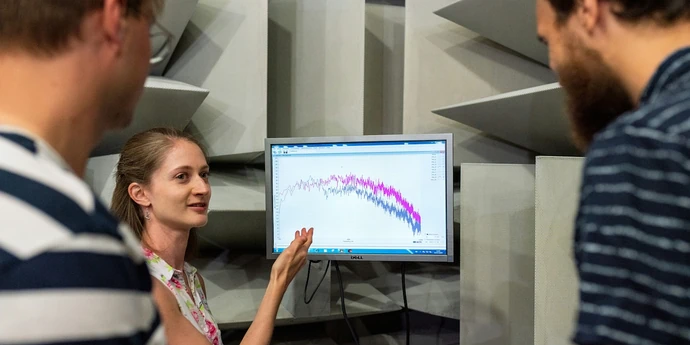If you’re interviewing for a tech role at Amazon (or AWS), be prepared to face lots of behavioral questions focused on Amazon's leadership principles.
No other FAANG company uses behavioral questions quite as much as Amazon does. Behavioral questions form the core of the Amazon interview process, no matter what role you're applying for.
You'll be required to give detailed, structured answers that target a variety of leadership principles, and you'll need to respond convincingly to tricky follow-up questions as the interviewer probes for specific details.
Luckily, we're here to help.
This interview prep guide gives you everything you need to know to crack Amazon’s behavioral interview, including example questions targeting each leadership principle, how to answer them, insight and tips from ex-Amazon interviewers, and a practice plan to make sure you land your dream job at the company.
Thanks to Dessy, ex-Amazon interviewer and Senior PM, and Bilwasiva, Applied Scientist and interviewer at Amazon, for their expert collaboration on this article.
Here’s a brief overview of what we’ll cover.
- What is a behavioral interview at Amazon and what are its leadership principles?
- 60+ Amazon behavioral interview questions
- How to answer Amazon behavioral interview questions (with example answers)
- Amazon behavioral interview tips
- How to prepare for an Amazon behavioral interview
Click here to practice 1-on-1 with ex-Amazon interviewers
1. What is a behavioral interview at Amazon?↑
Amazon uses behavioral interviews to assess job candidates based on their past experiences. These questions typically start with “Tell me about a time you…” and focus on soft skills articulated in the 16 leadership principles. Areas of focus usually include leadership, ambiguity, problem-solving, bias for action, etc. (we'll go into more detail on these below.)
For more information on the process for a specific role, consult one of our comprehensive interview guides below:
- Amazon product manager
- Amazon program manager
- Amazon technical program manager
- Amazon software development engineer
- Amazon software development manager
- Amazon data scientist
- Amazon applied scientist
- Amazon (technical) account manager
- Amazon machine learning engineer
- Amazon data engineer
Now, what will your interviewers be looking out for? Let’s take a look at those leadership principles.
1.1 What is Amazon looking for in a candidate?
As we mentioned before, learning and demonstrating your adherence to their leadership principles is key to landing your dream job at Amazon. Interviewers like the Bar Raiser are frequently assigned one or multiple leadership principles to focus on per round, meaning that you’ll encounter them at every stage. There are even reports of interviewers asking candidates to recite each principle from memory.
So it’s imperative that you prepare at least one practical example from your past that demonstrates each principle. As you may be asked more than one question on a given principle, we’d also recommend crafting a few ‘flex’ stories that you can apply to different principles. See more on answer techniques in section 3.
1.2 What are Amazon's leadership principles?
Amazon's Leadership Principles encapsulate the core values and behaviors that guide decision-making and actions across the company. Each principle emphasizes different aspects of Amazon's culture, from prioritizing customer needs to fostering innovation, maintaining high standards, and acting with urgency and integrity.
The idea is that these principles serve as a common language and framework for Amazonians to align their work and behaviors with the company's long-term vision and goals. As you might have guessed, candidates need to be very familiar with them!

Amazon’s leadership principles:
- Customer Obsession
- Ownership
- Bias for Action
- Have Backbone; Disagree and Commit
- Invent and Simplify
- Dive Deep
- Are Right, A Lot
- Deliver Results
- Think Big
- Hire and Develop the Best
- Frugality
- Learn and Be Curious
- Insist on the Highest Standards
- Earn Trust
- Strive to be Earth's Best Employer
- Success and Scale Bring Broad Responsibility
In section 2 we’ll dig deeper into each principle and the interview questions that will test you on them.
2. 60+ Amazon behavioral interview questions↑
To help you prepare strategically for your job interview, we have used Glassdoor data to identify the real questions asked in different Amazon interviews. The questions we’ve chosen come from our research on five Amazon tech roles: product manager, TPM, program manager, software development engineer, and data scientist.
The questions below can appear at every step of the interview process at Amazon and AWS, from the initial recruiter screen all the way through to the onsite interviews. Some could even appear as ice-breakers or transition questions during technical screens. The frequency and type of behavioral questions will vary per role, but be prepared to answer many.
Let’s get into it.
2.1 Amazon behavioral questions: Top 5
First, we wanted to highlight the most common behavioral questions that Amazon asks across every role we’ve studied. You’ll likely be asked at least one of these questions. You’ll see that regardless of the role, Amazon is curious about why you want to work for them specifically, how you face setbacks, and whether you’re willing to stand up for your ideas.
Here are the questions.
Example behavioral questions asked at Amazon: Top 5
- Why Amazon? (watch an example answer from an ex-Amazon interviewer)
- Tell me about a time you failed at work. What did you learn from it?
- Tell me about a challenge you faced. What was your role & the outcome?
- Tell me about a time you disagreed with a coworker/manager/decision
- Tell me about a time you had to work or make a decision quickly / under a tight deadline
Right, let's go through more common behavioral questions at Amazon.
Each category below tests a different leadership principle, and the frequency of questions testing certain principles will vary depending on the role. For instance, interviews for managerial roles will include a higher number of questions targeting the principles “hire and develop the best” or “strive to be Earth’s best employer.”
2.2 Amazon behavioral questions: Customer obsession
“Leaders start with the customer and work backwards. They work vigorously to earn and keep customer trust. Although leaders pay attention to competitors, they obsess over customers.”
Empathy is important in all customer obsession questions. Interviewers want to see that you understand the consequences that every decision has on customer experience. You need to know who the customer is as well as their underlying needs.
Example behavioral questions asked at Amazon: Customer obsession
- Tell me about a time you had to deal with a difficult customer
- Tell me about one of your projects where you put the customer first
- Which company has the best customer service and why?
- Describe a time when a customer asked you for one thing, but you knew that they needed something else
How to answer customer obsession questions (according to Bilwasiva, an Amazon interviewer):
- Begin by explaining the significance of customer obsession at Amazon, emphasizing that it's the foundation of everything the company does.
- Provide examples of how you've prioritized customer needs in your previous roles, showcasing your commitment to understanding and addressing customer pain points.
- Discuss specific initiatives or projects where you've gone above and beyond to deliver exceptional customer experiences, highlighting the outcomes and impact.
2.3 Amazon behavioral questions: Ownership
“Leaders are owners. They think long-term and don’t sacrifice long-term value for short-term results. They act on behalf of the entire company, beyond just their own team. They never say 'That’s not my job.'"
To work at Amazon, you can’t be a person who thinks, “That’s not my job!” when facing a task that needs to get done. When answering ownership questions, you’ll want to prove that you take initiative, can make tough decisions, and accept responsibility for your mistakes.
Dessy (ex-interviewer/Senior PM at Amazon) told us that Amazon loves "single-threaded-ownership", where each project/product belongs to one person. "It makes accountability very clear and means there's no potential for people passing blame around", Dessy says.
Example behavioral questions asked at Amazon: Ownership
- Tell me about a time you did something at work that wasn't your responsibility / in your job description
- Tell me about a time when you went over and above your job responsibility in order to help the company
- Tell me about a time when you had to make an important decision without approval from your boss
- How would you make Amazon.com better?
How to answer ownership questions (according to Dessy, ex-Amazon interviewer):
- Be ready to talk about how you own a product or feature end-to-end.
- Even though you work cross-functionally or with other stakeholders, show how you go to extreme distance to follow through on your projects and do whatever it takes to deliver
- For example, you escalate to other team's leadership if necessary.
2.4 Amazon behavioral questions: Bias for action
“Bias for Action — Speed matters in business. Many decisions and actions are reversible and do not need extensive study. We value calculated risk-taking.”
Amazon likes to learn by doing, with an eye on results over user projections and research. This is part of what helps them act quickly and ship their products to customers as fast as they do. So your interviewer will want to see that you can take calculated risks and move things forward.
Example behavioral questions asked at Amazon: Bias for action
- Tell me about a time you had to make an urgent decision without data
- Tell me about a time when you launched a feature with known risks
- Tell me about a time when you found an opportunity that no one else saw.
How to answer Bias for action questions (according to Bilwasiva, Amazon interviewer):
- Discuss how you prioritize action and drive momentum in your work, highlighting instances where you've made decisions quickly and decisively.
- Provide examples of how you've taken calculated risks to achieve desired outcomes, demonstrating your ability to navigate ambiguity and drive results in a fast-paced environment.
- Emphasize the importance of learning from failures and iterating on ideas to continuously improve and move forward.
2.5 Amazon behavioral questions: Have backbone; disagree and commit
"Leaders are obligated to respectfully challenge decisions when they disagree, even when doing so is uncomfortable or exhausting. Leaders have conviction and are tenacious. They do not compromise for the sake of social cohesion. Once a decision is determined, they commit wholly.”
Any group of smart leaders will disagree at some point. Your interviewer will want to see that you know when to challenge ideas and escalate problems to senior leadership if necessary. At the same time, they want to know that you can sense the right time to move forward regardless of your disagreement. Show that you’re capable of striking that balance.
Example behavioral questions asked at Amazon: Have backbone; disagree and commit
- Tell me about a time you had a conflict with a coworker or manager and how you approached it
- Tell me about a time your work was criticized
- Tell me about a time when people in your team didn't agree with you
- Tell me about a time you had a conflict with your team but decided to go ahead with their proposal
How to answer Have backbone; disagree and commit questions (according to a Dessy, ex-Amazon interviewer):
- Have an example ready where you were able to deliver successfully on a project even though you had voiced your disagreement earlier in the process
- Show that you understand the pros & cons of a certain decision (even though you don't 100% agree, you can still see the merit of the decision).
2.6 Amazon behavioral questions: Invent and simplify
"Leaders expect and require innovation and invention from their teams and always find ways to simplify. They are externally aware, look for new ideas from everywhere, and are not limited by “not invented here." Because we do new things, we accept that we may be misunderstood for long periods of time.”
As Dessy explained to us, teams at Amazon operate relatively independently and are almost like their own start-ups. This is because, despite its vast size, Amazon likes to move quickly and launch things fast.
Related to this is the fact that engineering resources are always limited ("Frugality" being another principle!) and so products are launched at minimum viability. Interviewers want to know that you can respond to these limitations and thrive under them.
Example behavioral questions asked at Amazon: Invent and simplify
- Tell me about a time you re-designed a process and why
- Tell me about a time you solved a big problem in your company
- Tell me about a time when you had a plan but ran into some obstacles. What did you do about it?
- What is the most innovative idea you've ever had?
How to answer Invent and simplify questions (according to a Dessy, ex-Amazon interviewer):
- Describe how you came up with a MVP or phase 1 in a long-term project.
- Think about examples where you've come up with innovative, alternative solutions instead of building a feature that required engineering resources.
- For example, maybe you used a Google form instead of building your own registration form, or changing the standard operating procedure instead of building a separate feature.
2.7 Amazon behavioral questions: Dive deep
"Leaders operate at all levels, stay connected to the details, audit frequently, and are skeptical when metrics and anecdote differ. No task is beneath them.”
When something isn’t working, Amazon employees need to be able to find solutions quickly. Interviewers want to see that you are excited to dive deep and work out a durable response when problems arise.
Example behavioral questions asked at Amazon: Dive deep
- Tell me about a project in which you had to deep dive into analysis
- Tell me about the most complex problem you have worked on
- Tell me about a time when you used a lot of data in a short period of time
How to answer Dive deep questions (according to Bilwasiva, Amazon interviewer):
- Illustrate your ability to analyze complex problems by sharing examples of how you've conducted thorough research, gathered data, and delved into root causes to understand underlying issues.
- Highlight instances where your attention to detail and analytical skills have enabled you to uncover insights and drive informed decision-making.
- Emphasize your willingness to dig deeper, ask probing questions, and challenge assumptions to arrive at effective solutions.
2.8 Amazon behavioral questions: Are right, a lot
"Leaders are right a lot. They have strong judgment and good instincts. They seek diverse perspectives and work to disconfirm their beliefs.”
Amazon expects its employees to produce solutions as quickly as possible and to be capable of making decisions with little information. Show that you know how to take calculated risks and that you're comfortable disproving your own opinions before moving ahead. When describing past failures, show what you’ve learned.
Example behavioral questions asked at Amazon: Are right, a lot
- Tell me how you deal with ambiguity
- Tell me about a time when you were faced with a problem that had a number of possible solutions.
- Tell me about a time you applied judgment to a decision when data was not available
2.9 Amazon behavioral questions: Deliver results
"Leaders focus on the key inputs for their business and deliver them with the right quality and in a timely fashion. Despite setbacks, they rise to the occasion and never settle.”
Amazon values action over perfection. When answering questions related to delivering results, you’ll want to indicate that you work to avoid slipped deadlines and failed goals. If you have missed deadlines and goals in the past, explain the methods you’ve put in place to avoid this in the future.
Example behavioral questions asked at Amazon: Deliver results
- Tell me about a time you came across a scenario where the deadline given to you for a project was earlier than expected
- Tell me about the most challenging project you ever worked on
- Tell me about a time when you had to handle pressure
- Tell me about a time when you had two deadlines at the same time. How did you manage the situation?
- How do you prioritize tasks in your current role?
How to answer Deliver results questions (according to Bilwasiva, Amazon interviewer):
- Showcase your track record of delivering measurable results and achieving key objectives in your previous roles.
- Provide specific examples of projects or initiatives where you set clear goals, developed action plans, and executed effectively to drive impactful outcomes.
- Quantify your achievements wherever possible, using metrics and data to demonstrate the impact of your contributions.
2.10 Amazon behavioral questions: Think big
“Thinking small is a self-fulfilling prophecy. Leaders create and communicate a bold direction that inspires results. They think differently and look around corners for ways to serve customers.”
Amazon is an enormous company, and its employees need to build products and structures that reach a significant scale to make a difference for the business. As a result, interviewers will want to see that you can develop and articulate a bold vision.
Example behavioral questions asked at Amazon: Think big
- Tell me about your most significant accomplishment. Why was it significant?
- Tell me about a time you proposed a non-intuitive solution to a problem and how you identified that it required a different way of thinking
- What was the largest project you've executed?
How to answer Think big questions (according to Bilwasiva, Amazon interviewer):
- Discuss your ability to envision and pursue ambitious goals that have a transformative impact on your team, organization, or industry.
- Share examples of how you've challenged the status quo, pursued innovative ideas, and inspired others to think beyond conventional boundaries.
- Emphasize your long-term vision and strategic thinking, as well as your ability to break down big ideas into actionable plans and milestones.
2.11 Amazon behavioral questions: Hire and develop the best
"Leaders raise the performance bar with every hire and promotion. They recognize exceptional talent, and willingly move them throughout the organization. Leaders develop leaders and take seriously their role in coaching others. We work on behalf of our people to invent mechanisms for development like Career Choice.”
Amazon wants every new hire to “raise the bar.” Interviewers will want to see that you seek to hire people smarter than you. You should also show you enjoy coaching younger colleagues and know how to get the most out of top performers. This leadership principle is typically discussed in interviews for very senior engineering positions that involve people management or building a team.
Example behavioral questions asked at Amazon: Hire and develop the best
- Tell me about a time you provided feedback that was helpful to a peer
- Tell me about a time you hired or worked with people smarter than you are
- Tell me about a time you stepped in to help a struggling teammate
- Who is your best employee/resource, and what makes them the best?
How to answer Hire and develop the best questions (according to Bilwasiva, Amazon interviewer):
- Describe your approach to talent acquisition and development, emphasizing your commitment to building high-performing teams and cultivating a culture of learning and growth.
- Share examples of how you've recruited top talent, assessed candidates effectively, and onboarded new hires to set them up for success.
- Discuss your efforts to mentor, coach, and provide opportunities for skill development and career advancement to members of your team.
2.12 Amazon behavioral questions: Frugality
"Accomplish more with less. Constraints breed resourcefulness, self-sufficiency, and invention. There are no extra points for growing headcount, budget size, or fixed expense.”
Amazon strives to provide customers with as much value for as little cost as possible. Interviewers will be looking for how you can support this idea while maintaining a constant drive for innovation.
Example behavioral questions asked at Amazon: Frugality
- Tell me about a time you successfully delivered a project with limited budget or resources
- Tell me about the last time you figured out a way to keep an approach simple or to save on expenses
- When managing a budget, what are some ways you get more out of less?
2.13 Amazon behavioral questions: Learn and be curious
“Leaders are never done learning and always seek to improve themselves. They are curious about new possibilities and act to explore them.”
Amazon demands constant improvement in every part of its business. You’ll want to show that you are interested in learning new things and exploring new ideas that can be applied to the job. Some examples listed here are general interview questions, but they provide a perfect opportunity for you to address this principle.
Example behavioral questions asked by Amazon: Learn and be curious
- Tell me about a time you had to learn something quickly
- Tell me about your biggest career failure and what you learned from it
- Tell me about a time you taught yourself a skill
- Tell me about something you learned that made you better at your job
- Tell me about your biggest career failure and what you learned from it
How to answer Learn and be curious questions (according to Bilwasiva, Amazon interviewer):
- Highlight your passion for continuous learning and professional growth, emphasizing your curiosity and eagerness to explore new ideas, technologies, and methodologies.
- Share examples of how you've pursued learning opportunities, whether through formal education, self-study, or hands-on experimentation.
- Discuss specific instances where your curiosity led to valuable insights, innovations, or improvements in your work.
2.14 Amazon behavioral questions: Insist on the highest standards
"Leaders have relentlessly high standards — many people may think these standards are unreasonably high. Leaders are continually raising the bar and drive their teams to deliver high quality products, services, and processes. Leaders ensure that defects do not get sent down the line and that problems are fixed so they stay fixed.”
At Amazon, rarely is anything deemed “good enough.” They’d like to see how you have pushed yourself to reach standards that were difficult to meet, and how you will continue to do so in the future.
Example behavioral questions asked by Amazon: Insist on the highest standards
- Tell me about the most successful project you've done
- Tell me about a project that you wish you had done better and how you would do it differently today
- Tell me a time that a goal was hard to achieve. What did you learn from that?
- How would you improve this [project on your resume] if you had more time?
How to answer Insist on the highest standards (according to Bilwasiva, Amazon interviewer):
- Explain your uncompromising commitment to excellence and quality in everything you do, highlighting your attention to detail and pursuit of perfection.
- Share examples of how you've set and maintained high standards for yourself and your team, ensuring that deliverables meet or exceed expectations.
- Discuss how you've established processes, guidelines, and quality assurance measures to uphold standards and drive continuous improvement.
2.15 Amazon behavioral questions: Earn trust
“Leaders listen attentively, speak candidly, and treat others respectfully. They are vocally self-critical, even when doing so is awkward or embarrassing. Leaders do not believe their or their team’s body odor smells of perfume. They benchmark themselves and their teams against the best.”
The key part of this principle that candidates often miss is the “vocally self-critical” detail. Amazon wants its employees to focus on fixing mistakes instead of figuring out who to blame. You’ll want to show that you take action when something is wrong and acknowledge your own faults before resorting to blaming others.
Example behavioral questions asked by Amazon: Earn trust
- How do you earn trust with a team?
- Tell me a piece of difficult feedback you received and how you handled it
- A co-worker constantly arrives late to a recurring meeting. What would you do?
How to answer Earn trust questions (according to Bilwasiva, Amazon interviewer):
- Highlight your commitment to building trust and credibility with stakeholders, both internally and externally.
- Share examples of how you've demonstrated integrity, transparency, and reliability in your interactions and decision-making processes.
- Discuss your approach to building strong relationships based on mutual respect, open communication, and delivering on promises.
2.16 Amazon behavioral questions: Strive to be Earth’s best employer
"Leaders work every day to create a safer, more productive, higher performing, more diverse, and more just work environment. They lead with empathy, have fun at work, and make it easy for others to have fun. Leaders ask themselves: Are my fellow employees growing? Are they empowered? Are they ready for what's next? Leaders have a vision for and commitment to their employees' personal success, whether that be at Amazon or elsewhere.”
Like the principle “hire and develop the best,” this is more likely to come up in interviews for senior and/or managerial positions. In this case, you’ll want to show that you’ll not only boost your team, but also create a safe, diverse, and just work environment. Essentially, if “hire and develop the best” means picking and training a top team, being “Earth’s best employer” means keeping that team safe, enriched, and engaged once you’ve got them.
Example behavioral questions asked by Amazon: Strive to be Earth’s best employer
- How do you manage a low performer in the team?
- Tell me about a time that you went above and beyond for an employee
- Tell me about a time you saw an issue that would negatively impact your team. How did you deal with it?
- How do you identify a good performer in the team and help in their career growth?
2.17 Amazon behavioral questions: Success and scale bring broad responsibility
"We started in a garage, but we're not there anymore. We are big, we impact the world, and we are far from perfect. We must be humble and thoughtful about even the secondary effects of our actions. Our local communities, planet, and future generations need us to be better every day. We must begin each day with a determination to make better, do better, and be better for our customers, our employees, our partners, and the world at large. And we must end every day knowing we can do even more tomorrow. Leaders create more than they consume and always leave things better than how they found them.”
Amazon wants its employees to understand the responsibility of working for a vast, impactful company. Show how you measure the impact of your decisions, both in your workspace and in the world around you (e.g. sustainability, justice, etc.).
Example behavioral questions asked by Amazon: Success and scale bring broad responsibility
- Tell me about a time when you made a decision which impacted the team or the company
- Tell me about a decision that you made about your work and you regret now
- Tell me about a time when you failed to do the right thing
3. How to answer Amazon behavioral interview questions↑
Now that you’ve seen some of Amazon’s top questions, let’s work on a technique for answering them.
3.1 Technique
When answering behavioral questions, you should focus on your most relevant achievements and communicate them clearly. An easy way to achieve this is to use a step-by-step method to tell your stories.
The STAR method (Situation, Task, Action, Result) is a popular approach for answering behavioral questions because it’s easy to remember. You may have already heard of it. However, we’ve found that candidates often find it difficult to distinguish the difference between steps two and three, or task and action. Some also forget to include lessons learned in the results step, which is especially crucial when discussing past failures.
So we’ve developed our own, IGotAnOffer method to correct some of the pitfalls we’ve observed when using the STAR method. We call it the SPSIL method (not catchy, but it works!).
3.1.1 SPSIL method
Let’s step through our suggested five-step approach:
- Situation: Start by giving the necessary context of the situation you were in. Describe your role, the team, the organization, the market, etc. You should only give the minimum context needed to understand the problem and the solution in your story. Nothing more.
- Problem: Outline the problem you and your team were facing.
- Solution: Explain the solution you came up with to solve the problem. Step through how you went about implementing your solution, and focus on your contribution over what the team / larger organization did.
- Impact: Summarize the positive results you achieved for your team, department, and organization. As much as possible, quantify the impact.
- Lessons: Conclude with any lessons you might have learned in the process.
You’ll notice that this method covers very similar themes to the STAR method. We like it because a lot of the candidates we work with find this framework easier to use, as there’s no overlap between any of the steps in your story.
For a deeper dive into this topic, check out our article on why the STAR method isn’t always the best for behavioral interviews and how IGotAnOffer's SPSIL method can be a better option. It was written with product managers in mind, but applies just as well to any role.
Ultimately, you should practice using whatever method you’re the most comfortable with. If you’d like to start practicing right away, jump back to the full list of questions here.
Otherwise, to get a better idea of how our method works, work through the example below.
3.2 Example answer: Tell me about a time you failed at work. What did you learn from it?
Now that you know how to approach answering behavioral questions, let's look at a full example. We’ll use one of Amazon’s most frequently asked questions. You’ll see that it can be tailored to match a few different leadership principles, such as Ownership, Learn and Be Curious, and Deliver Results.
Try answering the question below following your preferred method. Play both the role of the interviewer and the candidate. Write down your answer, then practice saying it out loud before going through our example response. Once you’ve finished, compare your response to our example to fill in any gaps in your story.
Try this question:
Tell me about a time you failed at work. What did you learn from it?
Answer:
We’ll use the SPSIL method described above and answer as if interviewing for a product manager job at Amazon. You will find our proposed answer to the question below.
Note that this question isn’t necessarily about a specific role and allows you to describe a variety of situations. We’ll use a generic example, but you should of course use an example from your own work experience.
1. Situation
You could start by saying something like, “In my last position, I was the product manager for a key feature of a new product we were about to launch. My team had been able to roll through research and development ahead of schedule, so I was excited to beat our deadline. In an update with our chief product officer, I told her that we were working quickly and would likely finish a week before the deadline. She was pleased to hear this and rearranged launch dates accordingly.”
Without giving too much detail, this gives a quick sense of the setting you were in. Now we’ll get into the problem.
2. Problem
Once you outline the situation, you can explain the problem by saying something like, “However, I had allowed myself to get swept up in our previous progress and moved up our deadline without fully considering all the factors at play. As we continued work on the launch, it quickly became clear that the final details would take longer than anticipated, and we would not be meeting the earlier deadline.”
Here, you don’t spend too much time describing the situation and problem, but your answer so far has given the interviewer a clear sense of the setting and issue that arose.
3. Solution
When describing the solution you came up with to solve the problem, it’s important to step through your thinking. And it’s especially important to focus on YOUR contribution.
Of course, this will look a little different for a question asking about a failure, as it would mean you may not have solved the initial problem. However, you can underline the steps you took to address the failure once you realized it.
You could say something such as, “As it was my mistake to move up the deadline, and not my team’s, I took it upon myself to speed up the process. First, we discussed our progress, and I added some of their workload to my plate to accomplish everything faster. I worked overtime to take care of the loose ends, then booked a new meeting with the chief product officer.
I explained to her that I had spoken too hastily and that we would not meet the new deadline that I had imposed. We reworked the launch plan and returned to the original timeline.
Ultimately, we were able to complete our preparations a couple of days before the original launch date, though not a full week ahead like I'd anticipated.”
Let’s take a step back and look at what you’ve shown with this answer. While you are putting on display a big mistake, your work to resolve it shows personal accountability. Instead of blaming the mistake on others, you accept blame and act to fix it. This is a key aspect of Amazon’s Ownership leadership principle.
Also, you went out of your way to speed up the process, working overtime to arrive closer to the due date. This shows that you can Deliver Results, another leadership principle.
4. Impact
After explaining the actions you took, it’s a good idea to quantify both the impact of the failure itself and how you mitigated it.
You could say something like, “Clearly, the deadline mixup had some negative repercussions, as the launch date was pushed forward and then moved back again. Thankfully, since it was only the earlier deadline I failed to meet, the product was still able to be launched on the original launch date one week later.”
5. Lessons
Finally, wrap up your answer by describing any lessons you might have learned. This is the most important step for a question about a past mistake or failure, as Amazon wants to be sure you know how to avoid that mistake again. Also, constantly learning aligns with the principle Learn and Be Curious.
You could say, “The failure to meet that deadline reminded me to make decisions based on data and observation, not excitement. Also, the final details of a project are extremely important and shouldn’t be rushed. These were both things I had been aware of before, but I had forgotten them in the excitement over how quickly we were progressing in other areas. Thankfully, since this mistake, I’ve always been meticulous about deadlines, only setting or changing them after I’ve discussed them with the team and considered the repercussions. Thanks to that, I haven’t missed a deadline since. ”
3.3 Example answer: Customer Obsession
Let's see how you could answer a typical question on the customer obsession principle.
Question: "How have you previously measured customer satisfaction?"
Example answer (from Jason, ex-Amazon PM)
(Situation)
"In my role as a product manager in the Amazon Marketplace organization, I encountered a significant challenge regarding declining retention rates among customers purchasing from individual sellers.
(Problem)
Despite consistent conversion rates, there was a noticeable decline in repeat purchases, indicating dissatisfaction among customers with their overall experience.
(Solution)
To address this, I conducted extensive research by engaging with both customers and individual sellers to understand their pain points. Through one-on-one conversations and surveys, I delved into their satisfaction levels, browsing experiences, and purchase behaviors. Additionally, I analyzed metrics such as conversion rates and repeat purchases to gauge overall customer satisfaction.
(Impact)
By triangulating qualitative feedback with quantitative data, I was able to pinpoint areas for improvement and devise targeted solutions to enhance customer satisfaction. Implementing improvements such as enhancing product detail pages, adding more images, and improving product descriptions resulted in a notable increase in repeat purchases and overall customer satisfaction.
(Lessons)
This experience taught me the importance of combining qualitative and quantitative methods to gain a comprehensive understanding of customer satisfaction. It underscored the significance of proactive engagement with customers and continuous iteration to meet evolving needs and preferences."
3.4 Example answer: Bias for Action
Let's see how you could answer a typical question on the Bias for Action principle.
Question: Tell me about a time you struggled to meet a deadline
Example answer (from Jason, ex-Amazon PM)
(Situation)
"As a lead product manager for a travel company, I faced a daunting challenge of increasing mobile ad revenue, which was significantly below industry standards.
(Problem)
Tight deadlines and resistance from other product teams advocating for the removal of ads posed significant obstacles to achieving our revenue targets.
(Solution)
To tackle this challenge, I initiated a comprehensive strategy that involved leveraging existing technology infrastructure, conducting rigorous A/B testing, and prioritizing mobile web and app platforms.
(Impact)
Despite initial skepticism and tight deadlines, I led my team through the execution of nine A/B tests, with seven yielding positive results. Through meticulous analysis and iterative improvements, we not only met but exceeded our revenue targets, ultimately demonstrating the effectiveness of our approach and reinforcing the importance of perseverance in the face of adversity.
(Lessons)
This experience underscored the importance of resilience, strategic planning, and collaboration in overcoming challenges and meeting deadlines in a dynamic and fast-paced environment."
3.5 Example answer: Ownership
Let's see a typical question on the Ownership principle and what a good answer looks like.
Question: Tell me about a time you had to improve a difficult process
Example answer (from Dessy, ex-Senior PM at Amazon)
(Solution)
"While working in e-commerce, we aimed to enable sellers to accept cash on delivery, leading to complex money flow processes.
(Problem)
Inaccuracies in invoicing, due to multiple money flows for each transaction, resulted in a 5% error rate.
(Solution)
After analyzing transaction processes, I simplified money flows, reducing them from four to two, and implemented flexible payment methods for sellers.
(Impact)
Accuracy in invoicing improved to over 99.5%, saving $400,000 and reducing finance operation time from five hours to less than one hour monthly.
(Lessons)
Reviewing processes comprehensively and implementing strategic changes can significantly enhance efficiency and accuracy."
3.6 Example answer: Have Backbone, Disagree & Commit
Let's see what an answer to the common 'Have backbone, disagree & commit" principle might look like.
Question:
Example answer (from Dessy, ex-Senior PM at Amazon)
(Situation)
"While managing a tool for seller inventory management, my manager aimed to sunset an old widget quickly, but I disagreed due to potential customer impact.
(Problem)
The manager's timeline for sunsetting the old widget was too short, risking a negative customer experience.
(Solution)
I suggested a manual approach using a Google form for transitioning, allowing more time for customer migration without significant development.
(Impact)
By extending the migration period, 100% of impactful customers switched without negative customer experiences.
(Lessons)
Prioritizing customer experience and proposing practical interim solutions can prevent rushed decisions and ensure successful transitions."
3.7 Example answers: various
Answering behavioral questions can seem fairly straightforward on paper, but when you get into the actual interview, it can feel a bit more difficult.
We recommend watching and doing plenty of mock interviews. Check out the video below - Jason (ex Product Manager at Amazon) answers some very common leadership principle questions.
4. Amazon behavioral interview tips↑
Finally, before we move on to some interview prep resources, we'd like to give you five helpful tips to keep in mind.
#1 Get used to setting up the situation in 30 seconds or less
Use a timer while you practice to ensure you provide only necessary information. Spending too much time on the Situation step is one of the most common mistakes candidates make.
#2 Stay focused on essential details
Interviewers hear a lot of behavioral stories a day. If you go into unnecessary details you are likely to lose their attention. Share your stories with a few different people before your interview and ask them what details they would suggest cutting.
#3 Be proud and talk about YOU
This is not the time to be shy about your accomplishments. Concentrate on your impact, not what “the team” did. Not talking about YOU enough is another common mistake we see with a lot of candidates.
#4 Adapt to follow-up questions
Don’t be alarmed if your interviewer asks follow-up questions; this is perfectly normal. Listen carefully to the way your interviewer is asking these questions, as there will often be a subtle clue about the specific skills they’re looking to assess from the next part of your answer.
#5 Explain how failure made you better
When talking about failure, don’t try to hide your mistakes or frame a weakness as a strength. Instead, show what you learned and how you grew from the failure.
5. How to prepare for an Amazon behavioral interview↑
Right, now that we’ve been through all the questions and the techniques you can use to answer them, we’d like to offer some resources to help you prepare. Here are three steps that you can take to help you prepare for your Amazon or Amazon Web Services behavioral interview.
5.1 Learn about Amazon's culture
Most candidates fail to do this. But before investing tens of hours preparing for an interview at Amazon, you should take some time to make sure it's actually the right company for you.
Amazon is prestigious and it's tempting to assume that you should apply, without considering things more carefully. But it's important to remember that the prestige of a job alone won't make you happy in your day-to-day work. It's the type of work and the people you work with that will.
If you know people who work at Amazon or used to work there, talk to them to understand what the culture is like. The leadership principles we discussed above can give you a sense of what to expect, but there's no replacement for a conversation with an insider. Finally, we would also recommend reading the following resources:
- Amazon's technology culture video mix (by Amazon)
- Amazon vision and mission analysis (by Panmore Institute)
- Amazon strategy teardown (by CB Insights)
5.2 Practice by yourself
Acing a behavioral question is much harder than it looks. You’ll stand out if you put in the required work to craft concise and direct answers.
First, take a look at this video by Amazon aimed to help software development engineers prepare for behavioral interviews.
5.2.1 Write down your stories
Now that you've seen an example of a behavioral question at Amazon, work out which of your stories you’d like to tell. As mentioned in the video, make a list of key moments in your career (e.g. accomplishments, failures, team situations, leadership situations, etc.) that you can use to answer one or multiple questions. We’d recommend you come prepared with at least one story per leadership principle, as well as a few ‘flex’ stories that you could apply to multiple.
After you’ve finished your list, write out a story for each key moment in your career using the structure we've laid out in section 3. Be sure to emphasize your impact in each of these examples, quantify the results of your actions, and explain the lessons you learned from the experience.
Once you have a bank of stories, go through the questions in section 2 and make sure you’d be able to answer all of them either by using one of the stories you’ve written directly or by adapting it on the fly. If you identify any gaps, add stories to your bank until you’re comfortable you can cover all the questions listed in this article.
Click here to download a PDF to help you prepare stories on each Amazon leadership principle.
Click here to practice with more common behavioral questions and see example answers
5.2.2 Practice your stories out loud
After you've written everything down, a great way to practice your answers is to interview yourself out loud. This may sound strange, but it will significantly improve the way you communicate during an interview.
You should be able to tell each story naturally, neither missing key details nor memorizing them word-for-word.
Play the role of both the candidate and the interviewer, asking questions and answering them, just like two people would in an interview. Trust us, it works.
5.3 Practice with peers
Practicing by yourself will only take you so far. By yourself, you can’t simulate thinking on your feet or the pressure of performing in front of a stranger. Plus, there are no unexpected follow-up questions and no feedback.
That’s why many candidates try to practice with friends or peers. If you have friends or peers who can do mock interviews with you, that's an option worth trying. It’s free, but be warned, you may come up against the following problems:
- It’s hard to know if the feedback you get is accurate
- They’re unlikely to have insider knowledge of interviews at your target company
- On peer platforms, people often waste your time by not showing up
For those reasons, many candidates skip peer mock interviews and go straight to mock interviews with an expert.
5.4 Practice with experienced Amazon interviewers
In our experience, practicing real interviews with experts who can give you company-specific feedback makes a huge difference.
Find a behavioral interview coach so you can:
- Test yourself under real interview conditions
- Get accurate feedback from a real expert
- Build your confidence
- Get company-specific insights
- Learn how to tell the right stories, better.
- Save time by focusing your preparation
Landing a job at a big tech company often results in a $50,000 per year or more increase in total compensation. In our experience, three or four coaching sessions worth ~$500 significantly impact your ability to land the job. That’s an ROI of 100x!















